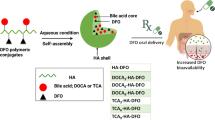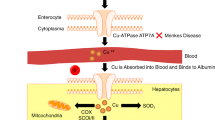Abstract
Iron deficiency is one of the most prominent mineral deficiencies around the world, which especially affects large population of women and children. Development of new technologies to combat iron deficiency is on high demand. Therefore, we developed alginate microcapsule with encapsulated iron that had better oral iron bioavailability. Microcapsules containing iron with varying ratios of sodium alginate ferric(III)-saccharide were prepared using emulsification method. In vitro studies with Caco-2 cells suggested that newly synthesized microemulsions had better iron bioavailability as compared to commercially available iron dextran formulations. Ferrozine in vitro assay showed that alginate-encapsulated ferric galactose microemulsion (AFGM) had highest iron bioavailability in comparison to other four ferric saccharate microemulsions, namely AFGlM, AFMM, AFSM, and AFFM synthesized in our laboratory. Mice studies also suggested that AFGM showed higher iron absorption as indicated by increased serum iron, hemoglobin, and other hematopoietic measures with almost no toxicity at tested doses. Development of iron-loaded microemulsions leads to higher bioavailability of iron and can provide alternative strategies to treat iron deficiency.





Similar content being viewed by others
Change history
17 December 2022
A Correction to this paper has been published: https://doi.org/10.1007/s12011-022-03522-x
Abbreviations
- FGlC:
-
Ferric-glucose complex
- FSC:
-
Ferric-sorbitol complex
- FFC:
-
Ferric-fructose complex
- FMC:
-
Ferric-mannose complex
- FGC:
-
Ferric-galactose complex
- AFGM:
-
Alginate-encapsulated ferric galactose microemulsion
- AFGlM:
-
Alginate-encapsulated ferric glucose microemulsion
- AFMM:
-
Alginate-encapsulated ferric mannose microemulsion
- AFSM:
-
Alginate-encapsulated ferric sorbitol microemulsion
- AFFM:
-
Alginate-encapsulated ferric fructose microemulsion
References
Kaur M, Bassi R, Sharma S (2011) Impact of nutrition education in reducing iron deficiency anemia in adolescent girls. Ind J Fund Appl Life Sci 1:222–228
Rohner F, Ernst FO, Arnold M, Hilbe M, Biebinger R, Ehrensperger F, Langhans W, Hurrell RF, Zimmermann MB (2007) Synthesis, characterization, and bioavailability in rats of ferric phosphate nanoparticles. J Nutr 137:614–619
Brock C, Curry H, Hanna C (1985) Adverse effects of iron supplementation: a comparative trial of a wax-matrix iron preparation and conventional ferrous sulfate tablets. Clin Ther 7:568–573
Litovitz TL, Klein-Schwartz W, Jr Rodgers GC, Cobaugh DJ, Youniss J, Omslaer JC, May ME, Woolf AD, Benson BE (2002) 2001 annual report of the American Association of Poison Control Centers Toxic Exposure Surveillance System. Am J Emerg Med 20:391–452
Geisser P, Baer M, Schaub E (1992) Structure/histotoxicity relationship of parenteral iron preparations. Arzneim Forsch 42:1439–1452
Sharma N (2001) Iron absorption: IPC therapy is superior to conventional iron salts. Obstet Gynecol, pp 515–519
McCord JM (1998) Iron, free radicals, and oxidative injury. Semin Hematol 35:5–12
Geisser P (1990) In vitro studies on interactions of iron salts and complexes with food stuffs and medicaments. Arzneimittelforschung 40:754–760
Jacobs P, Johnson G, Wood L (1984) Oral iron therapy in human subjects, comparative absorption between ferrous salts and iron polymaltose. J Med 15:367–377
Saha L, Pandhi P, Gopalan S, Malhotra S, Saha PK (2007) Comparison of efficacy, tolerability, and cost of iron polymaltose complex with ferrous sulphate in the treatment of iron deficiency anemia in pregnant women. Med Gen Med 9:1–15
Schümann K, Ettle T, Szegner B, Elsenhans B, Solomons NW (2007) On risks and benefits of iron supplementation recommendations for iron intake revisited. J Trace Elem Med Biol 21:147–168
Zimmermann MB (2004) The potential of encapsulated iron compounds in food fortification: a review. Int J Vitam Nutr Res 74:453–61
Wegmüller R, Zimmermann MB, Moretti D, Arnold M, Langhans W, Hurrell RF (2004) Particle size reduction and encapsulation affect the bioavailability of ferric pyrophosphate in rats. J Nutr 134:3301–3304
Yeo Y, Baek N, Park K (2001) Microencapsulation methods for delivery of protein drugs. Biotechnol Bioprocess Eng 6:213–230
Bock N, Dargaville TR, Woodruff MA (2014) Controlling microencapsulation and release of micronized proteins using poly (ethylene glycol) and electrospraying. Eur J Pharm Biopharm 87:366–377
Walter E, Moelling K, Pavlovic J, Merkle HP (1999) Microencapsulation of DNA using poly(DL-lactide-co-glycolide): stability issues and release characteristics. J Control Release 20:361–74
Alexakis T, Boadi DK, Quong D, Groboillot A, O’Neill I, Poncelet D, Neufeld RJ (1995) Microencapsulation of DNA within alginate microspheres and crosslinked chitosan membranes for in vivo application. Appl Biochem Biotechnol 50(1):93–106
Estevinho BN, Damas AM, Martins P, Rocha F (2014) Microencapsulation of β-galactosidase with different biopolymers by a spray-drying process. Food Res Int 64:134–140
Davila-Hicks P, Theil EC, Lönnerdal B (2004) Iron in ferritin or in salts (ferrous sulfate) is equally bioavailable in nonanemic women. Am J Clin Nutr 80:936–40
Theil EC, Chen H, Miranda C, Janser H, Elsenhans B, Núñez MT, Pizarro F, Schümann K (2012) Absorption of iron from ferritin is independent of heme iron and ferrous salts in women and rat intestinal segments. J Nutr 142:478–483
Silverstein SB, Rodgers GM (2004) Parenteral iron therapy options. Am J Hematol 76:74–78
Ortiz R, Tob-lli JE, Romero JD, Monterrosa B, Frer C, Macagno E, Breymann C (2011) Efficacy and safety of oral iron(III) polymaltose complex versus ferrous sulfate in pregnant women with iron-deficiency anemia: a multicenter, randomized, controlled study. J Matern Fetal Neonatal Med 24:1347–52
Yasa B, Agaoglu L, Unuvar E (2011) Efficacy, tolerability, and acceptability of iron hydroxide polymaltose complex versus ferrous sulfate: a randomized trial in pediatric patients with iron deficiency anemia. Int J Pediatr 2011:1-6
Silverberg DS, Blum M, Peer G, Kaplan E, Iaina A (1996) Intravenous ferric saccharate as an iron supplement in dialysis patients. Nephron 72:413–7
Richard D, Ibrahim M, Yvonne F, Laura C, Deepti HN (2012) Comparative efficacy of three forms of parenteral iron. J Blood Transfus 2012:1–3
Markus RJ, Thomas N, Sören F, Uwe W, Ute K, Peter L (2012) Iron Oxide/Hydroxide nanoparticles with negatively charged shells show increased uptake in Caco-2 cells. Mol Pharmaceutics 9:1628–1637
Rokstad AM, Brekke O, Steinkjer B, Ryan L, Kolláriková G, Strand BL, Skjåk-Bræk G, Lacík I, Espevik E, Mollnes TE (2011) Alginate microbeads are complement compatible, in contrast to polycation containing microcapsules, as revealed in a human whole blood model. Acta Biomater 7:2566–2578
Sk T, Bilodeau S, Dusseault J, Langlois G, Hallé JP, Yahia LH (2011) Biocompatibility and physicochemical characteristics of alginate–polycation microcapsules. Acta Biomater 7:1683–1692
Geetha K, Raghavan MSS, Kulshreshtha SK, Sasikala R, Rao CP (1995) Transition- metal saccharide chemistry: synthesis, spectroscopy, electrochemistry and magnetic susceptibility studies of iron (III) complexes of mono- and disaccharides. Carbohydr Res 271:163–175
Khosroyar S, Akbarzade A, Arjoman M, Safekordi AA, Mortazavi SA (2012) Ferric – Saccharate capsulation with alginate coating using the emulsification method. Afr J Microbiol Res 6:2455–2461
Fish W (1988) Rapid colorimetric micro method for the quantitation of complexed iron in biological samples. Methods Enzymol 158:357–364
Shappell NWE (2003) Rgovaline toxicity on Caco-2 cells as assessed by MTT, alamar Blue, and DNA assays. In Vitro Cell Dev Biol Anim 39:329–35
Reeves PG, Nielsen FH, Fahey GC (1993) AIN-93 purified the diets for laboratory rodents. J Nutr 123:1939–51
Siek G, Lawlor J, Pelczar D, Sane M, Musto J (2002) Direct serum total iron-binding capacity assay suitable for automated analyzers. Clinic Chem 48:161–166
Sharma D, Mathur R, Singh P (1993) Iron metabolism: a review. Indian J Clin Biochem 8:80–101
Wills ED (1996) Mechanisms of lipid peroxide formation in animal tissues. Biochem J 99:667–676
Wang H, Joseph JA (1999) Quantifying cellular oxidative stress by dichlorofluorescein assay using microplate reader. Free Radic Biol Med 27:612–616
Luck H (1963) Catalase. In: Bergemeyer HU (ed) Methods of enzymatic analysis. Acedemic Press, London, pp 885–891
Kono Y (1978) Generation of superoxide radical during autoxidation of hydroxylamine and an assay for superoxide dismutase. Arch Biochem Biophy 186:189–195
Kiernan JA (2008) Histological and histochemical methods, 4th edn. Scion publishing Ltd, Oxfordshire
Corrons JLV, Miguel MA, Pujades MA, Migual-Sosa A, Cambiazzo S, Linares M, Dibarrart MT, Calvo MA (1995) Increased susceptibility of microcytic red blood cells to in vitro oxidative stress. Eur J Haematol 55:327–331
Hawkins R (2007) Total iron binding capacity or transferrin concentration alone outperforms iron and saturation indices in predicting iron deficiency. Clinica Chemica Acta 380:203–207
Okada S (1996) Iron-induced tissue damage and cancer: the role of reactive oxygen species-free radicals. Pathol Int 46:311–332
Golovin AA, Konvai VD (1991) Lipid peroxidation in patients with iron deficiency anemia complicated by frequent acute respiratory distress. Klin Med 69:73–75
Acharya J, Punchard NA, Taylor JA (1991) Red cell lipid peroxidation and antioxidant enzymes in iron deficiency. Eur J Haematol 4:287–291
Komerova A, Lece A, Skesters A, Silova A, Petuhovs V (1998) Anemia and antioxidant defence of the red blood cells. Mater Med Pol 30:12–15
Meral A, Tuncel P, Sürmen-Gür E, Ozbek R, Oztürk E, Günay U (2000) Lipid peroxidation and antioxidant status in beta-thalassemia. Pediatr Hemat Oncol 17:687–693
Tekin S, Yavuzer M, Akar N, Cin S (2001) Possible effects of antioxidants status on increased platelet aggregation in childhood iron-deficiency anemia. Pediatr Int 43:74–77
Annan NT, Borza AD, Hansen LT (2008) Encapsulation in alginate-coated gelatin microspheres improves survival of the probiotic Bifidobacterium adolescentis 15703T during exposure to simulated gastro-intestinal conditions. Food Res Int 41:184–193
Rodvien R, Tarassoli M, Crosby WH (1994) The structure of spleen in experimentally induced iron deficiency anemia. Am J Pathol 75:242–254
Sherman AR, Guthrie HA, Wolinsky I, Zulak IM (1972) Iron deficiency hyperlipidemia in 18-day-old rat pups: effects of milk lipids, lipoprotein lipase and triglycarride synthesis. J Nutr 8:152–162
Acknowledgments
We acknowledge Dr. Vikas Rishi (NABI, Mohali) for his suggestions and help with analysis.
Funding Sources
Research was supported by the Department of Biotechnology and National Agri-Food Biotechnology Institute grants.
Author information
Authors and Affiliations
Corresponding author
Rights and permissions
About this article
Cite this article
Mukhija, K., Singhal, K., Angmo, S. et al. Potential of Alginate Encapsulated Ferric Saccharate Microemulsions to Ameliorate Iron Deficiency in Mice. Biol Trace Elem Res 172, 179–192 (2016). https://doi.org/10.1007/s12011-015-0564-4
Received:
Accepted:
Published:
Issue Date:
DOI: https://doi.org/10.1007/s12011-015-0564-4




